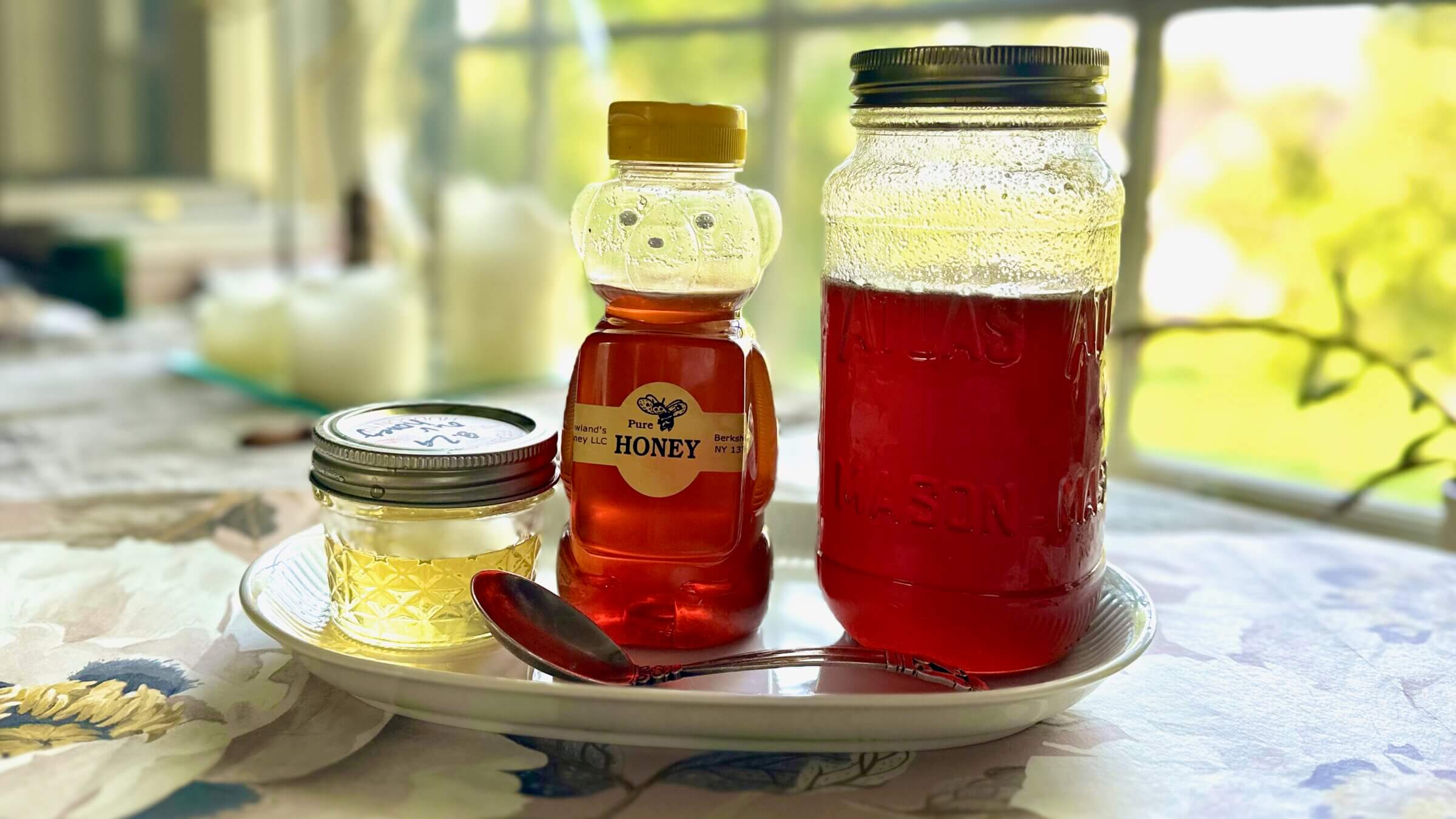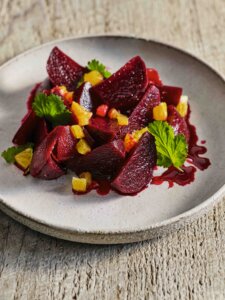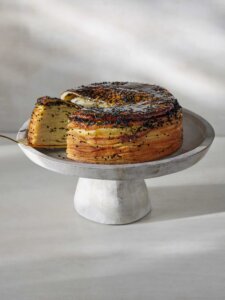This year, Americans and Israelis will be consuming 390 million pounds of this beloved Jewish ingredient
Turns out there’s a very good reason why the word ‘honey’ appears 55 times in the Hebrew Bible

Honey appears in Sumerian and Babylonian cuneiform inscriptions as far back as the 21st century B.C.E. Photo by Liza Schoenfein
Growing up on Kibbutz Dan in Israel’s Eastern Galilee, spice master Lior Lev Sercarz and his family never bought honey.
“I used to take an empty jar that my mom gave me and walk to the honey facility in the kibbutz and meet the old beekeeper, who was very nice and kind, and he poured the honey into the jar. If you were lucky enough, he’d give you a piece of honeycomb,” Lev Sercarz told me. “The spring honey would be different from the summer honey. I went horseback riding, and I would see the beehives — I’d see that ‘oh, they put them in the avocado fields, or in the apple fields.’”
In his third book, A Middle Eastern Pantry, the chef, author, and owner of La Boîte — a shop and laboratory in New York where Lev Sercarz develops aromatic spice blends for home cooks and restaurants — describes his sweet childhood experience in a chapter devoted to honey’s rich history and origins, how it’s made, and what it’s used for in different parts of the region. (The same treatment is given to countless other pantry staples, including syrups, sauces, pickles, nuts, grains and legumes, each accompanied by Lev Sercarz’s scrumptious recipes and Dan Perez’s sumptuous food photography.)
“To this day,” Lev Sercarz joked, “I go to the store and say, ‘Oh my god, people actually pay for honey?’”
Indeed they do. In 2022, Americans consumed 382 million pounds of the stuff, or roughly 1.2 pounds per person. In Israel, whose population is less than 3% of the U.S.’s, they consume 8 million pounds — roughly the same amount per capita as the U.S. — with a full 40% of that being eaten in the month of Tishrei, particularly on Rosh Hashanah.

Honey appears in Sumerian and Babylonian cuneiform inscriptions as far back as the 21st century B.C.E., in sacred Hindu texts, and in Egyptian writing such as the Tale of Sinuhe from the 20th century B.C.E. In A Middle Eastern Pantry, Lev Sercarz points out that Lower Egypt was once known as Bee Land and that it was the ancient Egyptians who first used human-made hives and figured out that smoke would subdue and control the bees.
Israel is referred to as “the land flowing with milk and honey” 16 times in the Hebrew Bible — and honey itself is mentioned 55 times. But with no mention of beekeeping, it was long thought that those references were to syrup made from dates or figs, and not from bees. Then in 2007, archaeologists uncovered a 3,000-year-old apiary in Tel Rahov in the Jordan Valley, containing around 30 hives. (It’s estimated that there were originally more like 100.) They had found the oldest commercial beekeeping facility in the Near East and Eastern Mediterranean world, according to archaeology professor Amihai Mazur of the Hebrew University of Jerusalem, who oversaw the excavation. The ancient Israelites, it seems, were familiar with the real thing.
As we prepare once again to dip our apples and challah into honey in hopes of a sweet New Year, some may wonder why the kosher laws permit the consumption of this golden syrup derived from a non-kosher insect. In A Halachic Guide to Honey and Bee Derivatives, Rabbi Dovid Heber writes that “honey is kosher since it is not an actual secretion of the bee; the bee functions only as a carrier and facilitator. Honey is kosher flower nectar, which enters the bee’s honey sac and is transformed into honey.”
So there you have it. And speaking of flower nectar, Lev Sercarz explains that the honey business started by Kibbutz Dan members in the 1960s became a thriving honey enterprise called Dan-Galil, now run by a former classmate of his, Zohar Rudolph. While most of the 100-140 tons of honey it produces annually is blended wildflower honey, Rudolph makes a few “mono varietal” honeys, including eucalyptus and avocado blossom.
“There’s no sign that says ‘Please only eat avocado pollen,’ but he’s quite confident that the parcels of the orchard are so distinct that [the bees] really are eating only one thing,” Lev Sercarz said.
Most of the income Dan-Galil generates isn’t from the sale of honey. “It’s for renting his bees and beehives to farmers so they can pollinate their crops,” Lev Sercarz said. Starting in mid-September, they don’t harvest any more honey. “The bees kind of go on their winter break, but they’re still very active. They’re in feeding mode, so [Rudolph] will drive them large distances and put them in farmers’ lands and orchards so the bees help pollinate different crops.”
“People don’t realize how important they are for the planet,” Lev Sercarz continued, stressing the environmental threats of climate change and a particular parasite known as Varroa destructor that’s killing honeybees around the world.
“Challenges like these, and collapsing honeybee populations, mean it’s more important than ever to support your local beekeepers,” he writes in his book.
Lev Sercarz concludes his honey chapter with a handful of beautiful recipes, any of which would make a fine addition to the Rosh Hashanah meal. These include bint el sahn, a layered Yemini honey cake that calls for toasted sesame oil and nigella seeds — and which might once and for all edge the standard Eastern European lekakh (honey cake) off the table. There’s also a recipe for kunafe, a honey-syrup-soaked phyllo-and-cheese-based wonder that Lev Sercarz calls his all-time favorite dessert.
On the savory (ish) side, there are honey-glazed beets with orange, which would make a beautiful jewel-toned side dish paired with a holiday chicken or brisket, and a sweet-and-sour vinegar-and-honey drink blended with cucumber, mint and lime. “If you’re skeptical of vinegar as a drink ingredient, this will convert you,” Lev Sercarz writes. “Think of it as a virgin cucumber-margarita-meets-a-mohito … And if you’re looking for an actual cocktail, add vodka.”
Lest the vinegar get in the way of the sweet-New-Year symbolism, you might save that recipe for after the High Holidays — and focus on these instead:
Honey-Glazed Beets with Orange
By Lior Lev Sercarz
Servings: 2 to 4 as a side dish
1 medium orange
1 pound beets, peeled and cut into ½-inch wedges
¼ cup honey
3 cardamom pods, cracked
½ teaspoon Aleppo pepper (1 gram)
½ teaspoon fine sea salt (3 grams)
1 garlic clove, smashed
2 tablespoons cider vinegar
¼ cup fresh cilantro leaves

Use a vegetable peeler to remove the zest of the orange in large strips; set aside. Trim the top and bottom of the orange so that it sits flat on the cutting board. Remove the pith by following the round shape of the orange with a knife, cutting from top to bottom. Finely dice the orange; discard any seeds.
In a large heavy-bottomed skillet or Dutch oven, arrange the beet wedges in a single layer and add the honey, cardamom, Aleppo pepper, salt, garlic, and reserved orange zest. Fill the skillet with enough water to cover the beets by 1 inch. Bring the water to a boil, then adjust the heat so the water simmers.
Cover and cook until the beets are tender, about 10 minutes.
Remove the cardamom pods and garlic. Add the vinegar and increase the heat to high. Reduce the liquid until it glazes the beets, swirling the pan as the liquid thickens so the beets are coated evenly. The time will vary depending on the dimensions of your pan and how much water was needed, but it may take up to 45 minutes or longer.
Garnish with the diced orange and cilantro and serve warm.
Reprinted with permission from A Middle Eastern Pantry: Essential Ingredients for Classic and Contemporary Recipes: A Cookbook. Copyright 2023 by Lior Lev Sercarz. Photography copyright 2023 by Dan Perez. Published by Clarkson Potter, an imprint of Penguin Random House.
Bint el Sahn
By Lior Lev Sercarz
Servings: 8
Dough
1 cup plus lukewarm water
1 tablespoon (250 grams), plus more as needed
2 tablespoons sugar (25 grams)
1 tablespoon instant yeast (10 grams)
2 cups bread flour (250 grams)
1 ¾ cups all-purpose flour (250 grams), plus more for rolling
1 ½ teaspoons fine sea salt (8 grams)
⅓ cup lukewarm milk (70 grams)
Assembly
8 ounces (2 sticks) unsalted butter (220 grams), melted, plus more for the pan
¼ cup toasted sesame oil (55 grams)
1 ⅓ cups honey (450 grams)
¼ cup plus nigella seeds
1 ½ teaspoons (35 grams)
1 large egg yolk

Make the dough: Put the lukewarm water into a small bowl or measuring cup and stir in the sugar and yeast until dissolved. Let sit until the yeast is foamy, about 10 minutes.
In a large bowl, stir together the bread flour, all-purpose flour, and salt. Make a well in the center and pour in the lukewarm milk and the yeast mixture. Slowly stir until a tacky, soft bread dough forms. Knead the dough in the bowl until it’s soft, stretchy, and still tacky, 10 to 12 minutes. If the dough is dry and isn’t sticking a bit to the bowl and your hands, add 1 to 2 tablespoons (15 to 30 grams) water to help get a soft texture. Cover with a dry cloth and proof until the dough doubles in size, about 1 hour.
Divide the dough into 12 equal portions (about 72 grams each) and shape them into balls. Cover with a damp cloth and let rest for 15 minutes.
Assemble the cake: Preheat the oven to 350 F. Generously butter the bottom and sides of a 10-inch springform pan.
In a small bowl, stir together the melted butter and the sesame oil.
Using a rolling pin and very little flour (the dough sticking a bit to your work surface helps stretch it out), roll one of the dough balls into a thin 10-inch round that’s nearly see-through. When rolling, give the dough a quarter-turn after a few rolls to keep the shape even, and if the dough shrinks after you remove it from your work surface, let it rest for a few minutes and try again.
Place the round of dough in the springform pan. Using a brush, generously drizzle about 1 tablespoon of the melted butter mixture over this layer of dough. Drizzle with 1 tablespoon (22 grams) of the honey.
Roll out another dough ball the same way. Stack it on top of the dough round in the pan, drizzle with the butter mixture, then sprinkle with 1 ½ teaspoons (5 grams) of the nigella seeds.
Repeat this process with all but one of the dough balls, drizzling honey on every odd layer and nigella seeds on every even layer. Reserve the remaining butter mixture, nigella seeds, and ample honey for finishing the cake.
For the final layer using the last ball of dough, roll it out to 11 inches. Place the dough on the top and tuck in the sides. In a small bowl, beat the egg yolk with 1 tablespoon (16 grams) of the butter mixture, 1 tablespoon (22 grams) of the honey, and 1 tablespoon (15 grams) water, then brush it over the top of the dough. Sprinkle evenly with the remaining nigella seeds.
Bake until the top of the cake is a deep golden color and the interior is light and spongy, about 40 minutes. If the top darkens too quickly, cover the pan with foil halfway through the baking time and reduce the oven temperature to 325 F.
Remove the pan from the oven and immediately drizzle the remaining butter mixture and the remaining honey on top of the cake. Let it soak in for at least 10 minutes. Serve the cake warm.
Reprinted with permission from A Middle Eastern Pantry: Essential Ingredients for Classic and Contemporary Recipes: A Cookbook. Copyright 2023 by Lior Lev Sercarz. Photography copyright 2023 by Dan Perez. Published by Clarkson Potter, an imprint of Penguin Random House.
























